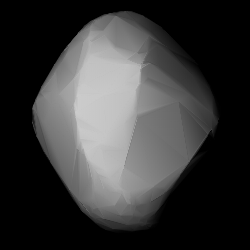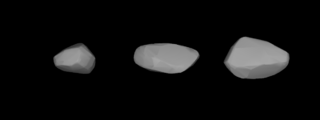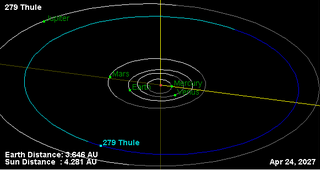Abundantia is a stony main belt asteroid. It was discovered by Johann Palisa on 1 November 1875, from the Austrian Naval Observatory in Pula. The name was chosen by Edmund Weiss of the Vienna Observatory; although the name refers to Abundantia, a Roman goddess of luck, it was also chosen to celebrate the increasing numbers of asteroids that were being discovered in the 1870s.

Hilda is a large asteroid in the outer main belt, with a diameter of 170 km. The spectrum matches that of a P-type asteroid. It was discovered by Johann Palisa on 2 November 1875, from the Austrian Naval Observatory at Pula, now Croatia. The name was chosen by the astronomer Theodor von Oppolzer, who named it after one of his daughters.

Medea is a very large main-belt asteroid that was discovered by Johann Palisa on February 6, 1880, in Pola, and was named after Medea, a figure in Greek mythology.

Bianca is a sizeable Main belt asteroid. It is an S-type asteroid. It was discovered by Johann Palisa on 4 September 1880, in Pola and was named after the Austro-Hungarian opera singer Bianca Bianchi. The Vienna newspapers contained several published accounts of the circumstances surrounding the honor extended to the diva in Spring 1882. In the late 1990s, a network of astronomers worldwide gathered lightcurve data that was ultimately used to derive the spin states and shape models of ten new asteroids, including (218) Bianca. The shape model for this asteroid is asymmetrical.

Oceana is an asteroid from the asteroid belt. It was discovered by Austrian astronomer Johann Palisa on 30 March 1882, in Vienna. It was named after the Pacific Ocean. Based upon its spectrum, it is classified as an M-type asteroid, but is not metallic.

Agathe is a stony main belt asteroid, about 9 kilometers in diameter. It was discovered by Johann Palisa on 19 August 1882 at Vienna Observatory, Austria. Photometric observations during 2003 showed a rotation period of 6.48 ± 0.01 hours with a brightness variation of 0.27 ± 0.03 in magnitude. An earlier study yielded results that are consistent with these estimates. Agathe is the lowest numbered asteroid to have an Earth-MOID as low as 0.657 AU (98.3 million km). On 23 August 2029 the asteroid will be 0.659 AU (98.6 million km) from Earth.

Augusta is a main-belt asteroid, discovered on 31 March 1886 by astronomer Johann Palisa at Vienna Observatory, Austria. The stony S-type asteroid measures about 12 kilometers in diameter. It is the first-numbered member of the Augusta family, after which the small Asteroid family and subgroup of the main-belt has been named. Augusta was named after the German–Austrian writer Auguste von Littrow (1819–1890), widow of astronomer Carl Ludwig von Littrow, who was a former director of the Vienna Observatory.

Anna is a typical Main belt asteroid.

Philagoria is a typical Main belt asteroid.

Thule, minor planet designation: 279 Thule, is a large asteroid from the outer asteroid belt. It is classified as a D-type asteroid and is probably composed of organic-rich silicates, carbon and anhydrous silicates. Thule was the first asteroid discovered with a semi-major axis greater than 4 AU. It was discovered by Johann Palisa on 25 October 1888 in Vienna and was named after the ultimate northern land of Thule.

Lucretia is an asteroid belonging to the Flora family in the Main Belt. It was discovered by Austrian astronomer Johann Palisa on 31 October 1888 in Vienna, and is named after the middle name of Caroline Herschel, one of the first female astronomers. Light curves of this asteroid show a synodic rotation period of 4.349±0.001 h with an amplitude of 0.3–0.4 magnitude. The spin axis appears nearly perpendicular to the ecliptic.

Katharina is a small Main belt asteroid orbiting in the Eos family of asteroids, including 513 Centesima and 221 Eos. It was discovered by Johann Palisa on 11 October 1891 in Vienna. It is named after the discoverer's mother.

Florentina is an S-type (stony) main belt asteroid with a diameter of 28 km. It was discovered by Johann Palisa on 15 October 1891 in Vienna. He named the asteroid for his daughter, Florentine. Between 1874 and 1923, Palisa discovered a total of 122 asteroids.

Tamara is a large Main belt asteroid. It is classified as a C-type asteroid and is probably composed of carbonaceous material. It is the largest member and namesake of the Tamara Family, a 264 million year-old sub-family of the collisional Phocaea family.

Arachne is a large Main belt asteroid. It is classified as a C-type asteroid and is probably composed of carbonaceous material. It was discovered on 13 October 1895, by German astronomer Max Wolf at Heidelberg Observatory.

Cornelia is a large Main belt asteroid. It was discovered by Auguste Charlois on 28 December 1896 in Nice. It is named after Cornelia Africana.
718 Erida is a minor planet orbiting the Sun. It was discovered at Vienna on September 29, 1911, by Austrian astronomer Johann Palisa, and was named for Erida Leuschner, daughter of astronomer Armin Otto Leuschner. It is orbiting at a distance of 3.06 AU with a period of 5.34 yr and an eccentricity of 0.20. The orbital plane of this asteroid is inclined by an angle of 6.9° to the plane of the ecliptic.

722 Frieda is a bright background asteroid and slow rotator from the inner regions of the asteroid belt. It was discovered by Austrian astronomer Johann Palisa at the Vienna Observatory on 18 October 1911. The stony S-type asteroid has a notably long rotation period of 131.1 hours and measures approximately 9 kilometers in diameter. It was named after Frieda Hillebrand, daughter of Austrian astronomer Karl Hillebrand (1861–1939), and grand-daughter of Edmund Weiss (1837–1917) who had been the director of the discovering observatory.
902 Probitas is a minor planet orbiting the Sun. It was discovered by an Austrian astronomer Johann Palisa in Vienna on 3 September 1918.
1053 Vigdis, provisional designation 1925 WA, is a bright background asteroid from the central regions of the asteroid belt, approximately 9 kilometers in diameter. It was discovered on 16 November 1925, by German astronomer Max Wolf at the Heidelberg-Königstuhl State Observatory in Heidelberg, Germany. The meaning of the asteroids's name is unknown.

















